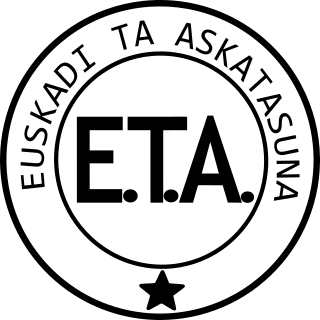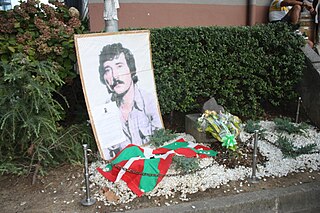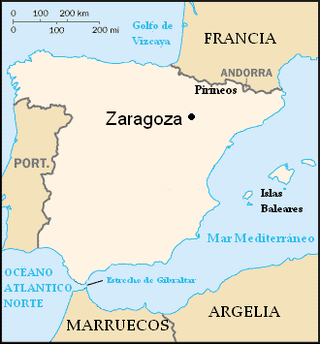
ETA, an acronym for Euskadi Ta Askatasuna, was an armed Basque nationalist and far-left separatist organization in the Basque Country between 1959 and 2018, with its goal being independence for the region. The group was founded in 1959 during the era of Francoist Spain, and later evolved from a pacifist group promoting traditional Basque culture to a violent paramilitary group. It engaged in a campaign of bombings, assassinations, and kidnappings throughout Spain and especially the Southern Basque Country against the regime, which was highly centralised and hostile to the expression of non-Castilian minority identities. ETA was the main group within the Basque National Liberation Movement and was the most important Basque participant in the Basque conflict.

Euzko Gudarostea was the name of the army commanded by the Basque Government during the Spanish Civil War. It was formed by Basque nationalists, socialists, communists, anarchists and republicans under the direction of lehendakari José Antonio Aguirre and coordinating with the army of the Second Spanish Republic. It fought the troops of Francisco Franco during 1936 and 1937. It surrendered to the Italian Corpo Truppe Volontarie at Santoña, while the rest of the Republican army kept fighting until 1939. This event is called the Santoña Agreement, Pact of Santoña, or Treason of Santoña by some Spanish leftists.

GAL were death squads illegally established by officials of the Spanish government to fight against ETA, the principal Basque separatist militant group. They were active from 1983 to 1987 under Spanish Socialist Workers' Party (PSOE)-led governments.

Salvador Puig Antich was a Spanish militant anarchist from Catalonia. His execution for involvement in a bank robbery and shooting a police officer dead became a cause célèbre in Francoist Spain for Catalan autonomists, pro-independence supporters, and anarchists. After fighting the Spanish state with the terrorist group Iberian Liberation Movement in the early 1970s, he was convicted and executed by garrote for the death of a police officer during a shoot-out.
Txabi Etxebarrieta, also known as Xabier Etxebarrieta Ortiz, was a Basque nationalist and one of the founders of the armed pro-independence organization Euskadi ta Askatasuna (ETA). He was the perpetrator of the first assassination carried out by this group, and also the first ETA militant killed in a confrontation with the Civil Guard, for which he became an icon within the inner circle of the group and its supporters.
Mikel Lejarza Eguía is a former member of the Spanish intelligence service. During the 1970s, he infiltrated the Basque separatist organisation ETA, providing safe houses in Spain to lodge their commandos. His secret service nickname was El Lobo.

The Revolutionary Antifascist Patriotic Front (FRAP) (Spanish: Frente Revolucionario Antifascista y Patriota, sometimes also Frente Revolucionario Antifascista y Patriótico; Catalan: Front Revolucionari Antifeixista i Patriota) was a radical Spanish anti-Francoist, Marxist–Leninist revolutionary organization that operated in the 1970s. This group was initially inspired by the success of the student demonstrations of May 1968 in France.

Luis Pío Moa Rodríguez better known as simply Pío Moa, is a Spanish writer and journalist. He has authored historical essays about the origins of the Spanish Civil War, the Second Republic in Spain, Francoism and the various political movements of that era.

The Basque conflict, also known as the Spain–ETA conflict, was an armed and political conflict from 1959 to 2011 between Spain and the Basque National Liberation Movement, a group of social and political Basque organizations which sought independence from Spain and France. The movement was built around the separatist organization ETA, which had launched a campaign of attacks against Spanish administrations since 1959. ETA had been proscribed as a terrorist organization by the Spanish, British, French and American authorities at different moments. The conflict took place mostly on Spanish soil, although to a smaller degree it was also present in France, which was primarily used as a safe haven by ETA members. It was the longest running violent conflict in modern Western Europe. It has been sometimes referred to as "Europe's longest war".

A car bomb attack was carried out by the Basque separatist organisation ETA on 11 December 1987. A vehicle containing 250 kilograms (550 lb) of ammonal was parked beside the main Guardia Civil barrack headquarter in the city of Zaragoza, Aragon, Spain; its subsequent explosion killed 11 people, including 5 children. Another 88 people were injured, the majority of them civilians.

The 1978 Spanish Constitution bans capital punishment in Spain, except for wartime offences. Spain completely abolished capital punishment for all offenses, including during wartime conditions, in October 1995.
The 1980 Zarautz attack was a mass shooting gun attack by the Basque separatist organisation ETA which occurred on 3 November 1980 in the Basque town of Zarautz in Gipuzkoa. The targets were several off duty civil guards belonging to the traffic department, who were drinking in a bar in the town. The attack was the second deadliest of 1980, the year when ETA killed more people than any other.
A car bomb attack was carried out by the armed Basque separatist group ETA in the Puente de Vallecas district of Madrid, Spain on 11 December 1995, which killed 6 people and injured a further 19. The target was a camouflaged army vehicle which was transporting nine civilian employees of the army towards the nearby motorway.
Basque National Liberation Movement prisoners are all those people who have been imprisoned, placed on remand, or otherwise kept in custody due to their illegal activity in support of the Basque National Liberation Movement.
The assassination of Augusto Unceta Barrenechea was an attack by the Basque separatist group ETA which took place on 8 October 1977 in Guernica in the Basque Country in northern Spain.

The Segovia prison break occurred in Segovia, Spain on 5 April 1976 when 29 political prisoners escaped from Segovia prison. This was the largest prison break in Spain since the Spanish Civil War. The prisoners escaped by means of tunnels they had excavated and then through the prison's drainage system. Hidden in a truck, they fled in the direction of the French border. Before reaching the border, their escape plans broke down and they found themselves stranded and lost in woodland in Navarre. Most of them were recaptured after a confrontation with the Civil Guards in Espinal, during which one of the prisoners was shot dead. The remaining four escapees managed to cross the French border and were detained by the French government, but escaped once again. In 1977, the Spanish authorities declared a general amnesty, after which the escapees were freed or could return to Spain.

María Dolores González Katarain, also known as Yoyes, was an iconic woman leader of Basque terrorist group ETA, who became a symbol because of the tragic circumstances of her life.
José Luis López de Lacalle Arnal was a Spanish journalist and trade unionist. A columnist for El Mundo newspaper, he was killed by ETA.

Genoveva Forest Tarrat was a Spanish far-left activist, writer and political prisoner. Born into an anarchist family in Barcelona, she studied medicine in Madrid. During the 1970s, she supported the Basque separatist group ETA in their resistance to the government of dictator Francisco Franco. From 1974 to 1977, she was imprisoned for alleged complicity in the Cafetería Rolando bombing (1974) which killed 13 people in Madrid. After Spain's transition to democracy, she served a term as a senator from 1992 until 1993. The wife of the Spanish writer Alfonso Sastre, she died in May 2007.

The Burgos trials were a series of military tribunals held in the Spanish city of Burgos from 3 to 9 December 1970. The trials prosecuted 16 members of the Basque separatist organisation Euskadi Ta Askatasuna (ETA) for their involvement in two murders of police officers in 1968. Causing international outrage and sympathy for the defendants, the trials are best known for six death sentences handed out by the tribunals which were later commuted to lengthy prison spells.














